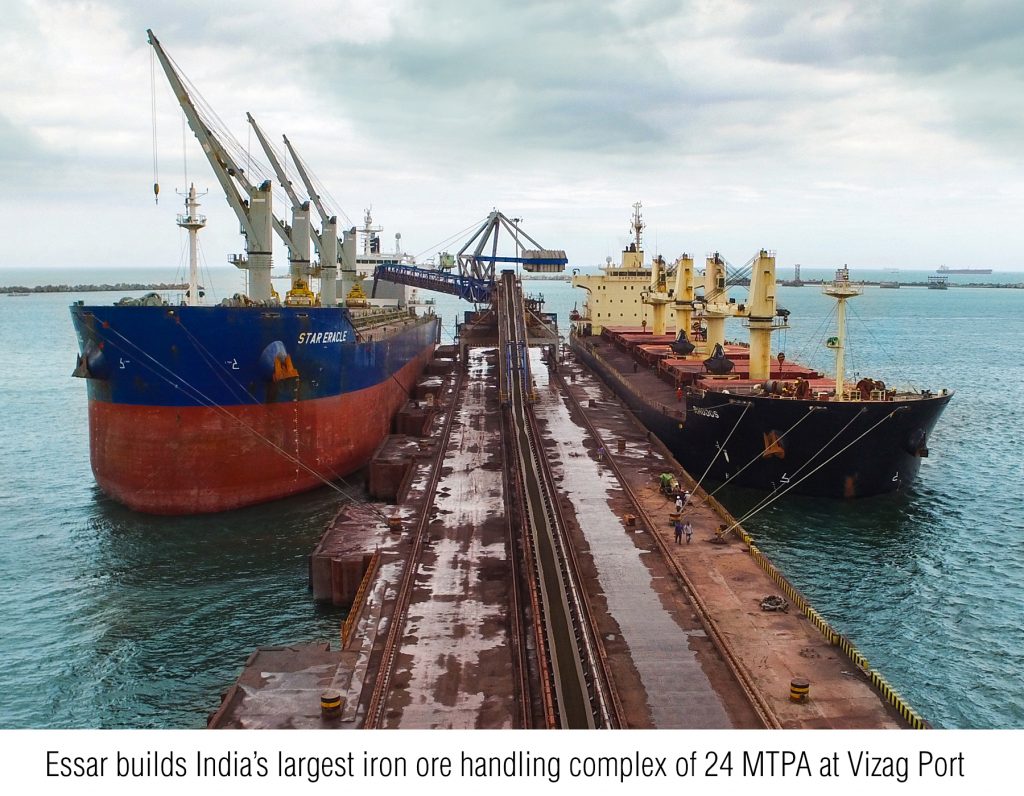The acquisition bolsters AM/NS India’s strategy to integrate the Company’s manufacturing and logistics chain for seamless connectivity and supply chain security for movement of raw materials and finished goods.
ArcelorMittal Nippon Steel India Ltd (AM/NS India) will acquire a 16 million tonne (mt) capacity iron terminal at Visakhapatnam Port from a unit of Essar Group for some Rs800-1,000 crore as the joint venture steel maker snaps up port assets that are intrinsic to the steel plant at Hazira which it acquired under India’s bankruptcy law.
Essar Vizag Terminals Ltd (EVTL), a wholly owned unit of Essar Ports Ltd (EPL), acquired the Iron Ore Handling Complex at Visakhapatnam Port that was previously run by the state-owned port authority, under a privatisation programme of the government.
Essar Vizag Terminals clinched the 30-year deal in an auction by placing the highest revenue share of 31.05 percent with the port authority.
“The Board of Visakhapatnam Port Authority has cleared the proposal submitted by Essar Vizag Terminals to sell the facility to AM/NS India subject to security clearance from the Central government,” a Visakhapatnam Port Authority official said. Security clearance from the Centre is mandated for private cargo contracts and mergers and acquisitions at major ports or those run by the Union Government.
“The security clearance for the deal is expected within a month,” the official said. “Once it comes, we will issue a no objection certificate to the transaction,” he added.
Essar Vizag Terminals took over the ore handling complex of Visakhapatnam Port in May 2015 by paying an upfront payment of Rs185 crore to the port authority. In addition, it is contractually mandated to pay a revenue share of 31.05 percent annually to the port authority.
The terminal comprises three berths (two outer harbour berths and one inner harbour berth) with a combined capacity of 23 mt.
After taking over the terminal, Essar has invested some Rs800 crores to upgrade the outer harbour berths (OB I & II) and mechanize the inner harbour berth (WQ-I).
The mechanized facility at the terminal includes wagon tipplers for receiving cargo by rakes, transferring cargo through conveyor system to stackyard having multiple stackers and reclaimers and loading into vessels through ship loaders.
The terminal can accommodate super Capesize vessels and has dedicated rail-connectivity with Bacheli and Kirandal mines by which it has the advantage to serve India’s western-sector. It is also integrated with AM/NS India’s 8 mt iron ore pellet plant in Vizag through a fully mechanized conveying facility with 6.7 km shipping conveyor system.
“The pellet plant at Vizag is totally dependent on the iron ore handling complex at the port for transporting the pellets to the Hazira steel mill,” the Visakhapatnam Port Authority official said.
The terminal is strategically located in the Bay of Bengal in close proximity to the iron ore mines located in Chhattisgarh, Southern Odisha and Jharkhand.
The facility has dedicated rail connectivity to India’s iron ore mining belt.
The all-weather deep draft facility has the capacity to serve the rapidly growing markets of South-East Asia, including China, Japan, and Korea, in addition to coastal movement for the steel industry within India.
In 2022, AN/NS India acquired some port, power and other logistics and infrastructure assets from the Essar Group for $2.05 billion (about Rs16,500 crores).
The deal comprised a 25 mt captive port along with a 270 MW power plant at Hazira and a 12 mt captive berth at Paradip Port.
The assets are either captive or allied to AM/NS India’s steelmaking and will strengthen the strategic integration of the Company’s manufacturing and logistics chain and ensure seamless connectivity and supply chain security for movement of raw materials and finished goods between the steel maker’s manufacturing facilities in western, eastern, and southern India, as well as for exports, AM/NS said while announcing the deal.
AM/NS India will be able to realise further synergies from rising throughput at the port assets because of the company’s planned expansion of steel production capacity, it added.







